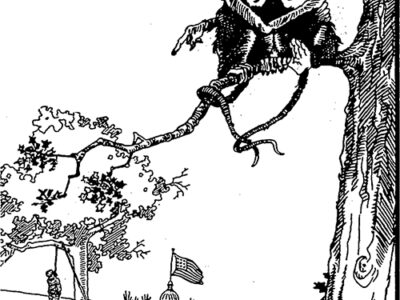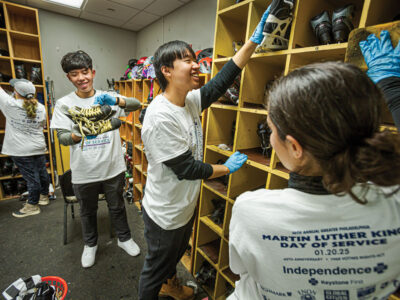It brought together ministers and mayors, city commissioners and scholars. It combined impassioned testimonials to the constructive power of organized religion in urban areas with dispassionate examinations of strategies and managerial systems. It offered hope — with a sobering underpinning of reality.
The theme of the three-day Steinberg Symposium, sponsored by Trustee Saul Steinberg, W’59, and Gayfryd Steinberg and put on by the School of Arts and Sciences this past November, was “Beyond Ideology: Discovering Hope for America’s Cities, in Leadership, Management, and Faith.” The keynote speaker, panel moderator, and general star of the show was Dr. John J. DiIulio, Jr., C/G’80 [see “John DiIulio Gets Religion,” October 1997], the professor of politics and public affairs at Princeton University who serves as director of the Partnership for Research on Religion and At-Risk Youth at the Philadelphia-based Public/ Private Ventures and as director of The Jeremiah Project, through which he studies and assists faith-based programs for inner-city youth that emphasize literacy, avoiding violence, and getting jobs.
Given adequate financial support, DiIulio told the audience in his keynote address, faith-based partnerships and outreach ministries “can and will do more and better of what they in fact in this country have already done: mainly to provide a personal, spiritual, and challenging menu of urban social services.”
Example: Having witnessed record-high rates of killing and youth-violence in the poorest neighborhoods of the Dorchester section of Boston, DiIulio noted that he had “heard that horrific noise cease as the result of innovative partnerships” between law-enforcement officials and the youth-outreach ministry of Rev. Eugene S. Rivers III (who joined DiIulio on the “Faith-Based Initiatives” panel that evening). The result, he said, was a “two-year period during which there was not a single gun-related youth homicide in the city of Boston.”
Beyond that, DiIulio said, he had personally witnessed
“how dozens upon dozens of these young people, once sullen and angry,
have begun to read, to write, smile, work, and otherwise turn themselves
around under the awesome influence of unconditional love delivered by
responsible adults who live where they live, walk the streets where they
walk, and are there for them, for real, twenty-four, seven, three-sixty-five.”
But noting that “the plural of anecdote is not
data,” DiIulio cited plenty of statistics to support the view that
faith-based communities do in fact reach severely at-risk urban youth.
One survey of more than 100 urban churches and four synagogues in six
cities, for example — undertaken by Dr. Ram Cnaan, associate professor
of social work at Penn (who also sat on the faith-based-initiatives panel)
— found that, on average, each church “provides over 5,300 hours
of volunteer support and community programs — the equivalent of about
two and a half full-time volunteers” — and roughly $140,000 a year
in community programs. And, DiIulio added, the primary beneficiaries were
“unchurched poor children.”
While DiIulio acknowledged that there are “all
manner of good secular mentoring programs,” he argued that “even
the best of these programs almost never actually reach the worst-off urban
youth.” For a child to be matched up with a Big Brother or Big Sister,
he noted, “it is presupposed that the youth already has at least
one adult in his or her life who is sufficiently functional” to sign
up and follow through on the required interviews and procedures. And unfortunately,
many children in American cities “do not have even that one ‘together’
adult already in their lives.”
But where conventional social services and mentoring
programs normally end, he said, “faith-based programs begin.”
Which would explain why he supported the “charitablechoice”
provision of the “otherwise painful welfare-reform bill” passed
by Congress; it “encourages states to utilize faith-based organizations
in serving the poor and needy,” and allows religious organizations
to receive contracts and other government funding “on the same basis
as any other non-governmental body.”
DiIulio acknowledged that there was no guarantee of
public support for “religion as a tool for addressing those problems,”
and noted that there were “political and Constitutional questions
that must inevitably surround and will inevitably challenge any effort
to take these urban-outreach efforts to scale, whether in a particular
city or nationally.”
After DiIulio’s talk, Dr. Thomas Sugrue, associate professor
of history and sociology, joined Dr. Elijah Anderson (Clarence and William
Day Professor of Sociology) and Dr. Kathryn Edin (assistant professor
of sociology) in critiquing the speech. DiIulio is “absolutely right
that the academic world has paid relatively little attention to religion
and to [faith-based] organizations,” said Sugrue, and the whole topic
of religion is “one of the most woefully neglected in the American
academy, the subject of distrust and even derision.” While “much
of the academic skepticism about organized religion is warranted,”
he maintained, there are also “enormously important” contributions
that faith-based organizations can make.
But Sugrue said he was worried about the “unwitting
role that churches and faith-based nonprofits can play in facilitating
the demise of a collective national social responsibility for our most
disadvantaged.” While it’s a “good thing that churches have
stepped in to fill the many gaps in our social safety nets,” he acknowledged,
“it’s troublesome that many of our political leaders are using the
willingness” of those organizations to do so — since churches have
the “will but not the capacity to deal with the enormous content
of urban problems.”
In the panel discussion on faith-based initiatives,
however, it was clear that for many urban ministers, those programs succeed
where secular programs don’t. The Rev. Rivers recalled how after “20
years of digesting all of the secular theorizing and all of the endless
reams of psycho-socio-babble, I decided, ‘Let me resume residence on the
planet Earth,’ and tried to launch some initiatives that can empirically
improve the life-chances of young people.”
From a series of dialogues with “then-members of
crack houses,” he recalled, came a political program that became
known as the Ten Point Program. The drug dealers, Rivers noted, told him
that in the inner cities today, unlike in the politically-active days
of the 1960s, “nihilism and decay and the death of hope now overshadows
a generation of young people who do not see any political possibilities.”
And in that bleak environment, “you must reintroduce a vocabulary
and a world-view of faith that resurrects their imaginations, so that
they can see the moral and theological basis for organizing.”
The Rev. Isaac Miller of the Church of the Advocate
in Philadelphia also spoke of the “hope that faith allows in the
midst of hopelessness,” explaining: “Those of us that are at
least my age remember something about a time when that kind of hopelessness
was not so abundant; we remember something about a time when faith in
a sense was in the air, even if you didn’t go to church — it was there
and it was tangible. Our young people in these times don’t have that kind
of opportunity for that faith-by- osmosis, and therefore we’ve got to
be much more articulate, much more aggressive, in speaking the word of
faith in all struggles and all forms.”
The Rev. Dr. Harold Dean Trulear, vice president of
Public/ Private Ventures and director of Church Collaboration Initiatives,
listed the characteristics of successful faith-based programs: “Clearly
directed leadership”; caring adults; a staff in which “faith
is at the center” and which has a “real sense of call”
(unlike public education); an emphasis on peer relationships; and high
residential memberships (since some urban churches are now attended by
an increasingly suburban, “commuter” congregation). In addition,
he said, a successful program must “target the population, not the
neighborhood,” since one that targets a neighborhood will reach the
“B and C students, not the F students” who most need help; and
it should feature collaborative programs with other churches.
Toward the end of the discussion, the Rev. Eugene Williams
of the Los Angeles Metropolitan Churches remarked that some of his more
left-leaning colleagues might question how he could justify being in a
working relationship with DiIulio. After all, he said, DiIulio is one
of the nation’s “leading conservative thinkers,” and had coined
the word super-predator to describe the newest strain of intractable
criminals — a term that had an ominously charged ring for African Americans.
He paused for a moment.
“And to those people I say: ‘Listen: when I needed
someone to help me find a place of refuge, it was John DiIulio. And if
I wanted to be part of the solution, then I need to be in a relationship
with him. And so if you have a problem with political correctness, you
need to leave that at the boardrooms or go to your nice tea.'”
While the importance of forming partnerships with churches
and other community organizations was touched on during the “Innovations
in Urban Public Management” panel discussion, Philadelphia’s police,
health, and recreation commissioners all stressed the importance of good
management systems, strategies, and leadership. They were joined by Dr.
Jack Nagel, professor of political science, and Dr. Theodore Hershberg,
the professor of history and public policy who serves as director of the
Center for Greater Philadelphia.
“I spent 29 years in the New York City Police Department,”
said Philadelphia Police Commissioner John F. Timoney, “and I spent
the first 25 years doing everything wrong.” Timoney, along with former
New York Police Commissioner William Bratton, has been heralded for the
dramatic drop in violent crime in New York — and he has been getting
rave press notices since arriving in Philadelphia last year. In his early
years, he said, the prevailing view was that since the police couldn’t
affect the root causes of crime, they could only react to crime, not prevent
it. “I rejected that notion throughout my career,” he said,
and five years ago he finally got a chance to test his own ideas.
His well-documented approach to crime-fighting includes
arresting “the second and third perpetrators” of a crime as
well as the first through “relentless follow-up and pursuit”;
getting “timely and accurate” crime statistics (something Philadelphia
has been sorely lacking); and then immediately deploying police resources
into the high-crime areas. Timoney also emphasized the importance of correct
organization in the department, and of setting up “systems that will
take the department into the future” to assure that good policies
survive changes in leadership.
“It is very exciting to see all the great things
happening in Philadelphia,” said Hershberg, after the commissioners
had spoken. “But I’m telling you, the next recession that hits the
city, watch out. All of it is going to blow away just like the weather
changes — it is that serious an issue.
“Like a gumball machine,” he added, “the
jobs and the people just follow gravity to the lower cost structures that
exist outside our boundaries.” And despite the reductions in crime,
and the progress in the Philadelphia public-school system, the problems
of crime and education will continue to be significantly worse in the
city than outside it.
He called for “a dialogue with our Republican brethren
in the suburbs, where we talk about ‘What it is that cities have to do
— which, if they do, they will become worthy partners at the dance?'”
Because without outside help, he concluded, “we
will fail for lack of resources, ultimately, and we will fail because
I don’t think you can sustain the political will” — since the next
city administration will not have either the crisis to force change or
the “quality of people” to carry it out. Echoing Timoney, he
asked: “How do you create a system so that the right kind of people
and the right kind of systems are in place to sustain these reform agendas?”
A similarly sobering assessment was offered by the usually
upbeat Edward G. Rendell, C’65, mayor of Philadelphia, during the
“Political Leadership in America’s Cities” panel discussion.
He and his administration have earned high marks for restoring financial
solvency and stopping the flow of jobs from the city, but after listening
to his fellow mayors from Indianapolis, Baltimore, and New Orleans describe
their strategies and accomplishments, Rendell suggested that the notion
that cities have conquered their problems is “illusory” — as
is the widely promulgated theory that “welfare- reform is an enormous
success.”
What Congress and the news media don’t understand, he
added, is that “like every pool of people, there are gradations in
the pool, and what we’ve done so far is we’ve taken roughly 20 percent
of that pool — in terms of work experience, literacy skills, drug and
alcohol problems — and transitioned them to jobs in the best economy
of the American 20th century. That’s a different kettle of fish from taking
the next 80 percent — particularly the last 20 or 30 or 40 percent —
and transitioning them.”
He spoke movingly of seeing the cheerful enthusiasm
of inner-city children give way to a “total lack of hope” by
the time they became teenagers. “When there’s a lack of hope, all
hell breaks loose,” he said. “We are facing serious problems,
exacerbated by the perception that cities are out of the woods.”
But the accomplishments and strategies of the four mayors
were nonetheless impressive and instructive. Stephen Goldsmith, mayor
of Indianapolis and the lone Republican on the panel, noted that his administration’s
first step was to make the delivery of city services “much more effective”
in terms of improving quality and reducing costs. By privatizing some
public services “in order to free up a substantial amount of capital,”
he noted that “we have now invested a billion dollars in roads and
bridges and streets and sidewalks and sewers and affordable housing.”
But neither the marketplace nor improved government
services and infrastructure alone could guarantee a vibrant community
in the 21st century, he realized, because “there isn’t enough police
muscle to make everybody good if they don’t wish to be good.” What
was needed was a “core set of values” among all citizens to
respect people and property, and he said that instilling those values
in some areas often required the help of faith-based institutions.
That realization led to the city’s Front Porch Alliance,
which now boasts some 800 partnerships and 400 neighborhood and faith-based
groups. “When we take our privatization initiative and contract with
20 churches to maintain 40 urban parks, it’s not just that the parks are
cleaner and free of graffiti,” he said by way of an example, “but
they become neighborhood parks — an oasis of safety through which the
church can reach out to families and children in that community.”
New Orleans Mayor Marc Morial, C’80, recalled
that his four years in West Philadelphia while a student at Penn gave
him a preview of some of the urban problems he would have to deal with.
Noting that New Orleans had more than 30,000 abandoned housing units when
he took office, as well as an archaic state constitution that made it
difficult to “get title to those homes,” Morial said: “We
developed some programs in which churches and community- based organizations
have been the leading entities, working with banks to rehab those homes.
And when the ministers come and say, ‘How about that abandoned house,
how about that abandoned building?’ my answer to them is always, ‘Let
me give you the money and you can go fix it,’ because they can do it better
than we can do it.
“I think this third way of doing business is going
to creep up to the states and creep up to the feds,” Morial concluded.
“I think Americans are tired of the dogmatic ideology in politics,
and I think what we’re seeing with American mayors and you’ve seen with
cities is the beginning of pragmatic government — government where you
can embrace a philosophy no matter whose textbook or playbook it comes
from.”




